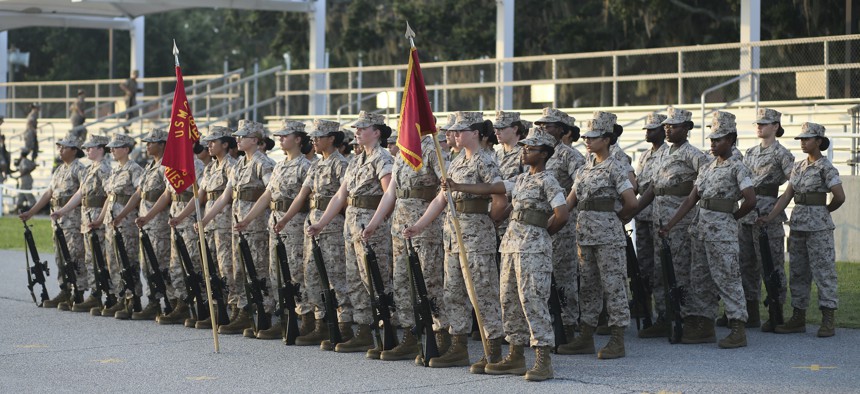
U.S. Marine Corps recruits with Platoon 4027, Oscar Company, 4th Battalion, Recruit Training Regiment, stand in formation during a final drill evaluation at Peatross parade deck on Marine Corps Recruit Depot, Parris Island, S.C., July 19, 2017. U.S. Marine Corps / Lance Cpl. Colby Cooper
Plan to Draft Women is Uniting Unlikely Political Allies
Anti-war activists and conservative hawks both want women to stay out of the Selective Service System.
China hawk Sen. Josh Hawley normally has little in common with anti-war group Code Pink. But the two are on the same side when it comes to keeping women out of the draft.
Congress is expected to debate this year whether women should register with the selective service, when it considers the fiscal 2022 National Defense Authorization Act. The fight is uniting advocates on opposite extremes of the political spectrum, even if their reasons for supporting or opposing the change are different.
“It’s a weird pairing,” said Kara Vuic, an expert on women in the military who teaches at Texas Christian University. “They’re united because they don’t want women going to war, whether that’s because they don’t want anybody going to war or because they think women should be in the home….It is bringing together people both for and against who probably agree with each other on absolutely nothing else.”
The objections are likely to fall flat. There is bipartisan support in both the House and Senate for the proposal requiring women to register. The House has already approved the bill, and the Senate Armed Services Committee voted the legislation out of committee with Republican support.
“Attaching it to NDAA basically ensures that it will [pass], barring a massive herculean effort to get it unattached somehow,” Vuic said. “I think it’s going to pass. It’s well past time.”
Those herculean efforts, however, are underway. Conservative news outlets are pressing officials on the issue. Code Pink is hosting webinars to push for abolishing the draft entirely, arguing that it’s not gender equality to coerce both men and women to join the military, said Carley Towne, the co-director at the nonprofit. And Hawley, R-Mo., who led Senate efforts to overturn the 2020 presidential election, introduced an amendment this week to fight against the proposal on the Senate floor.
“It is wrong to force our daughters, mothers, wives, and sisters to fight our wars,” Hawley said in a statement on Monday. “Volunteering for military service is not the same as being forced into it, and no woman should be compelled to do so.”
Despite this opposition, there are also GOP lawmakers who support it, including Rep. Mike Waltz, R-Fla., a former Army Green Beret who sponsored the amendment to add this provision in the House along with Rep. Chrissy Houlahan, D-Penn.
“I actually see less conservative opposition than ever in the past,” said Amy Rutenberg, a professor at Iowa State University, adding that this is “absolutely the farthest” the effort to require women to register has gotten on Capitol Hill.
There are also some non-traditional allies joining forces to support the change. The ACLU, which historically fights for women’s rights and against sex discrimination, worked with the National Coalition for Men, which fights to end discrimination and stereotyping against men, on a lawsuit, because both groups believe that a draft that excludes women is discriminatory.
A legal effort in 1981 to require women to register failed when the Supreme Court said drafting only men was constitutional because women at that time could not serve in combat. But multiple experts said a male-only draft is now unconstitutional by that same logic, since the ban on women serving in combat was lifted in 2016—though women served in war zones long before that.
The ACLU’s more recent lawsuit made it to the Supreme Court, which declined to consider the case in June because Congress is actively considering the proposal.
Congress seems poised to approve the change. The fiscal 2022 National Defense Authorization Act, which contains the provision, passed the House by a bipartisan 316-113 vote. The full Senate has not yet considered the bill, but the Senate Armed Services Committee approved the bill by a 23-3 vote, showing strong support from Republicans.
“My view is that we have a force now that would not be as effective or efficient without women,” Sen. Jack Reed, D-R.I., who chairs the Senate Armed Services Committee and proposed the language about drafting women, said Wednesday at the Aspen Security Forum. “I don’t think most women feel that they shouldn’t register. I think they should.”
President Joe Biden also supports women registering with the selective service. While running for president last September, he told the Military Officers Association of America that he would “ensure that women are also eligible to register for the Selective Service System so that men and women are treated equally in the event of future conflicts.”
And military leaders support the change as well. Joint Chiefs Chairman Gen. Mark Milley said at the Aspen Security Forum that all women who can meet the standards of military service are welcome to serve, though he added that no one is talking about bringing back the draft, which was last used in 1972.
Congress last considered whether to require women to register for the draft in 2016, when then-Rep. Duncan Hunter, R-Calif., introduced an amendment to the annual defense policy bill to make the point that if members didn’t support drafting women, they also should not support female troops serving in combat. To his surprise, the amendment passed the House, though it was stripped from the final bill. As a compromise, lawmakers instead ordered an independent commission to study the matter.
In March 2020, the commission released its report and recommended that both men and women between 18 and 26 years old should have to register with the selective service.
Women will have to register for the draft within one year of the bill passing, if the language remains in the legislation after negotiations. While the logistics of implementing are expected to be easy—women will simply register the same way men do, which happens automatically in many states when getting a driver's license—getting the public onboard will take more time, Rutenberg said. She expects the government will need to launch an aggressive public relations campaign to make people aware of the new law since, so far, the provision buried in the wonky defense authorization bill has not gotten a lot of attention among the broader population.
“I don’t think it’s been much on the radar,” she said. “Most people are totally unaware.”
Public support for adding women to the draft is dropping. In 2016, when Congress last debated the issue, 63 percent of Americans supported drafting both sexes. But an Ipsos poll in August found that number had dipped to just 45 percent. Support is even lower among women, only about a third of whom support the change.
Just as conflict looks drastically different now than it did at the end of the Vietnam War, experts predict the draft would also look different if it is ever reinstated. For example, as cyber warfare becomes a greater threat, Vuic predicted civilians with cyber skills could be conscripted to help the country, pointing as an example to an existing plan that could be activated to draft civilian medical personnel in a crisis.
Reed acknowledged that changing conflicts means different people can be best suited for the mission.
“We’re going to need a lot more people who can operate autonomous vehicles. You don’t have to be 6-foot-2 to do that,” he said.
Even in this form, restarting the Selective Service process and adding conscripts to the all-volunteer force is highly unlikely and would require a national emergency and action by Congress. But, Vuic said that no matter if women are ever actually drafted, adding women to the system is important for its symbolism alone.
“It’s the last legal distinction between the obligations of men and women as citizens,” she said, adding that both sexes are expected to act identical in other ways, such as serving on juries or paying taxes. “On paper, men and women will be completely equal.”
Don't miss:







